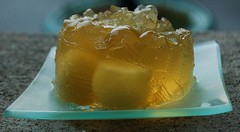Sorry about the slight hiatus in this series. Somehow, while I was living in rural Spain, I had no desire to cook meals from elderly English cookbooks. Tapas and very simple food were the order of the day.
This book is another tattered old favourite from my student days, with a really unappetising stew of some sort on the cover. Several pages fell out when I took it off the shelf. Georgina Horley is another no-nonsense type in the Delia mould, except she doesn’t spell things out in such detail. It was first published in 1969, and the recipes are very traditional English food, with a few foreign touches due to the author’s background as a Cordon Bleu instructor.
I found it invaluable when I was learning to cook, because it’s organised by month and focuses on fresh ingredients that are good and cheap (in the UK) in that month. It really helped me learn what to buy when, and how best to use cheap cuts of meat. It also has a section of “foundation recipes” at the front. This is where I learned to make bechamel sauce, pancake batter, pastry, scones, marmalade … other sections cover basic skills like filleting fish and sharpening knives, growing vegetables and herbs, making jam, and planning a kitchen. It really is a compendium of useful culinary information even if many of the actual recipes are dated.
As for the recipes, the most food-splattered page is Gertie Goslin’s Brown Stew. We used to eat this a lot; a dark, spicy beef stew enriched with pickled walnuts that tasted better as it aged, so was made in large quantities. I also fondly remember Madam Rigot’s Burgundian Potatoes, a dish of potatoes slowly simmered in milk until it was thick and creamy.
So, on to the menu. I cheated a little bit and transformed her sweet and sour tomato salad (simply sliced tomatoes, salt, and sugar) into tomato tartare. I followed it up with her classic chicken fricassee. This was good, although not as good as the blanquette I normally make; it lacked the all-important kick of a smidgin of curry powder. It might look a bit naff, but I rather liked the border of creamy mashed potato as a change from the plain boiled rice I normally serve with fricassee or blanquette. She also suggested using a border of puff pastry, which I think would be nice too, making a much more elegant dish.
And now dessert. Oh dear. Having some melon in the fridge that needed using up, I decided it would be a good idea to try her melon cooler: ginger-flavoured jelly with bits of melon suspended in it. Some conversion was required, from powdered gelatine to sheets. And ginger ale in “split-sized bottles” was a non-starter. In a perhaps misguided moment of inspiration, I decided to use some of my home-made vin d’orange instead. After all, melon and orange are a good combination.
At first I thought I’d got the gelatine conversion wrong, because it just wouldn’t set. “As jelly starts to set, push melon down evenly through mould,” says Aunty Georgina. Well, I tried, but my melon balls resolutely popped up to the top again. In the end I put the dishes in the fridge, where of course they set before I had a chance to arrange the melon nicely. It looked a fright when I turned it out, and could only exacerbate French people’s phobia of jelly. I quietly ate it myself, without showing it to anyone else. It had tasted dire when I first made it, really sharp and alcoholic, but a night in the fridge seemed to tone it down a bit. So it was edible, but I wouldn’t make it again.
Replacement improvised dessert: affogato. Put a scoop of vanilla ice cream in a glass, pour over a freshly made cup of espresso. Yum! No danger of slipping up here.


Hello Veronica – I know what you mean about jellies! I made some kiwifruit jelly yesterday, flavoured with Izarra – a pure green herb liqueur. It has set – just about – but it isn’t the colour I expected! A bit of a disappointment really. It’s probably something to do with ‘enzymes’ or some such!! Nothing ventured, nothing gained, so they say.
I do love blanquette though – I usually do that to use up turkey, so similar to yours, and I too use creamed potatoes rather than rice.
Hi Val
Jelly can look so pretty when it’s done right though! French people have a real phobia about jelly, I don’t know why. I have successfully served coffee jelly to French guests though 🙂
Hi,
five years on but if you use tinned or cooked fruit with jelly well that works, raw pineapple for example has emzymes which react with the proteins in the jelly and prevent setting..
Excellent and amusing:) Recently found this book in a junk shop which seems just as you say … was just wondering about it, then found your blog.
Thanks, this book was truly formative in my learning to cook!
I was given this book as a house warming present in 1978. I have used this a my reference book ever since, from UK to Australian outback and back to UK. My copy is very worn, faded and to my alarm the binding is going.
Pity no one has thought to reprint it.
Georgina’s book was a standby for foundation recipes when I first started cooking – I’ve just used it to check on her flaky pastry method. Her recipe for bread sauce is simple and brilliant. Its use of a chunk of bread instead of breadcrumbs and then beating the sauce to blend it in after resting gives it great texture. And there’s no cream in it!
Yep, she has really stood the test of time!